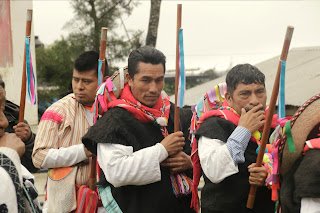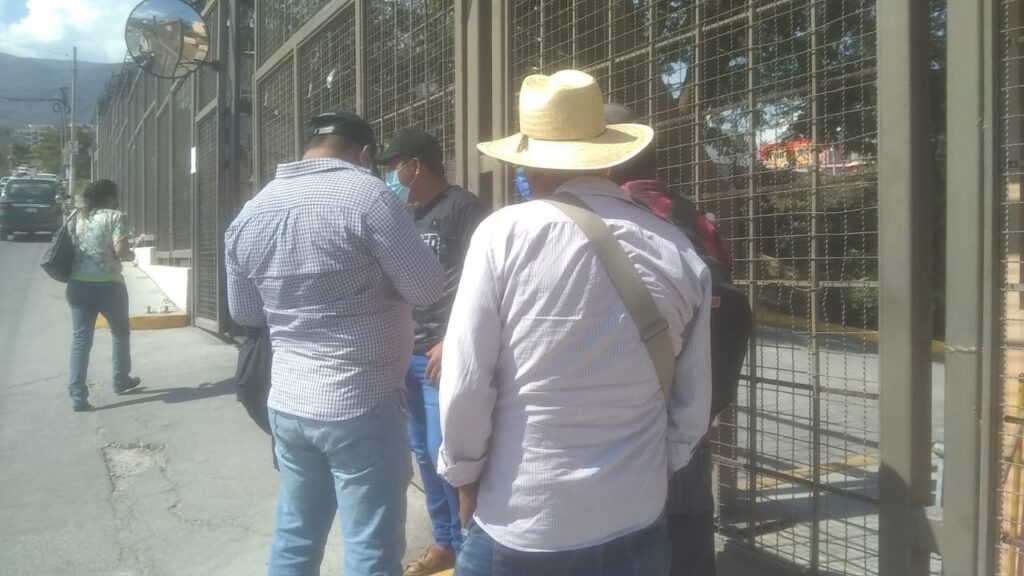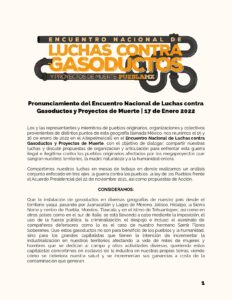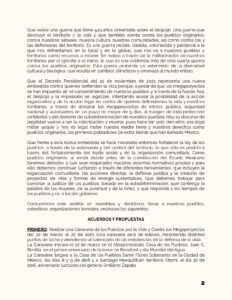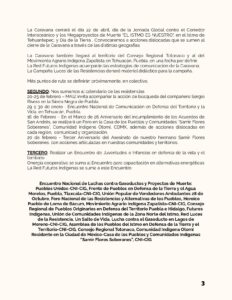
Pueblos Indígenas
(Español) Nuestro compañero preso en lucha Marcelino Ruiz Gómez, de la organización Vineketik en Resistencia, se suma a la exigencia de justicia por los ataques y asesinatos a periodistas
28/1/2022
CERSS nº 10 Comitán, Chiapas, México
COMUNICADO DE PRESOS INDÍGENAS EN LUCHA
Organización Viniketik en resistencia. Adherente a la Sexta declaración de la Selva Lacandona E.Z.L.N
Al Ejército Zapatista de Liberación Nacional.
A los y las defensoras de derechos humanos.
A la sexta nacional e internacional.
Al Congreso Nacional Indígena.
Al Consejo Indígena de Gobierno.
A los medios de comunicación.
Al Pueblo Creyente.
A la sociedad civil organizada.
Al pueblo de México y al mundo.
Queridas compañeras y compañeros, hermanas y hermanos, reciban mis saludos desde estas cuatro paredes con mucho cariño.
Al mismo tiempo, como presos tzotziles, les agradecemos el apoyo, su acompañamiento y solidaridad al estar pendientes de nosotros y de nuestro caminar a través de estos pasillos oscuros y fríos, pero sin bajar la antorcha de la esperanza, porque sabemos que no estamos solos, sino muchos los que estamos teniendo lazos de justicia y sembrando semillas de consciencia para cosechar justicia, esperanza, libertad y dignidad.
Sabemos que el enemigo opresor, la bestia capitalista, los poderosos y los políticos corruptos han estructurado el sistema político a beneficio suyo, y que les ha servido para oprimir a nuestros pueblos apropiándose de nuestros territorios, despojando las tierras, envenenando nuestros ríos, matando, desapareciendo, esclavizando y encarcelando. Y los medios de comunicación andan bombardeando con manipulaciones, escondiendo la verdad y publicando mentiras, quieren hacer creer a la sociedad a conveniencia de sus patrones los poderosos.
Cuántos periodistas de buen corazón que han sido asesinados, desaparecidos, sólo por informar la verdad y estar en contra de las mentiras de algunos, hasta algunos están en prisión.
Por todo ésto pedimos justicia y así todos juntos seguir caminando los que elegimos la vida y la libertad, organizándonos como hermanos que somos para juntos defender nuestros pueblos y nuestra madre tierra, nuestras raíces y vivir de acuerdo con nuestros corazones y seguir resistiendo con digna rebeldía.
¡Hasta que todos seamos libres!
Atentamente,
Organización Viniketik en Resistencia
Marcelino Ruiz
(Español) Frente a la arrograncia, discriminación, desprecio y criminalización que ejerce Adelfo Regino Montes, titular del INPI, en contra de la comunidad indígena otomí residente en la CDMX, damos a conocer nuestra palabra humilde pero verdadera
Ciudad de México a 26 de Enero de 2022
Al CCRI CG EZLN.
Al Ejército Zapatista de Liberación Nacional.
A la Comisión Sexta Zapatista del EZLN.
Al Congreso Nacional Indígena.
Al Concejo Indígena de Gobierno y su vocera, María de Jesús Patricio Martínez.
A las Redes de Resistencia y Rebeldía.
A la Sexta en México y el mundo.
A los Medios libres, independientes, alternativos o como se llamen.
A los Medios de Comunicación.
Al Pueblo de México.
Herman@s
Ante la traición, la mentira y el engaño no podemos quedarnos callad@s.
- Al titular del mal llamado INPI, Adelfo Regino Montes, ¿ya se le olvidó por que NO despacha en esta sede desde hace más de un año y tres meses?. ¿Por qué se llena la boca en decir, -refiriéndose a la Comunidad Otomí residente en la CDMX-, que: “Yo no he visto que tengan ellos la voluntad de llegar a acuerdos y de cumplirlos, sino que lo que he visto es que hay un conjunto de pretextos para seguir apoderándose de los bienes de la institución».
Le recordamos Sr. Adelfo Regino Montes, que tomamos esta institución como un acto de repudio a los ataques paramilitares en contra de nuestros herman@s zapatistas mismos que Usted traicionó; tomamos esta institución como un acto de repudio a la traición que desde estas oficinas ejercía -y sigue ejerciendo- usted, en contra de los pueblos originarios y comunidades indígenas y que al amparo y cobijo de la impunidad y el poder del dinero, se impusieron consultas a modo para imponer, los mega proyectos de muerte como el Tren Maya, el Corredor Interoceánico, el Proyecto Integral Morelos, el Aeropuerto Internacional de Santa Lucia y la Refinería de dos Bocas, entre otros; tomamos esta institución como acto de repudio a la indiferencia gubernamental para atender nuestras demandas más elementales: trabajo, alimentación, salud, cultura, vivienda, democracia, libertad y justicia. Sin embargo, como muestra un botón, a un año y tres meses seguimos esperando su respuesta.
- En días pasados, como tod@s lo sabemos, las noticias y las redes sociales, han dado cuenta que “Marcelo Ebrard, Secretario de Relaciones Exteriores, se pronunció a favor de que el acervo cultural que Banamex tiene en México y que se incluye entre los activos que Citibanamex ha anunciado que venderá debería formar parte del patrimonio nacional.” Esta nota fue el detonante, para que algunos funcionarios de la mal llamada Cuarta Transformación, se acordaran que al salir corriendo de esta Sede, se olvidaron del “Acervo de Arte Indígena”, que de acuerdo al libro “Arte y Memoria Indígena de México” y que publicara la extinta Comisión Nacional para el Desarrollo de los Pueblos Indígenas en 2014, es que supimos de la existencia de este Acervo.
- Es lamentable que Adelfo Regino Montes, ante el olvido y desprecio por el “Acervo de Arte Indígena” se justifique ante los medios de comunicación, señalando que “quienes mantienen tomada su sede en la Colonia Xoco no permiten el acceso a personal especializado”. Sr. Adelfo Regino Montes, Usted Miente; Usted dice que la Comunidad Otomí “impidió el ingreso al mismo para revisar el estado que guarda la valiosa colección.” Sr. Adelfo Regino Montes Usted Miente; tambien dice que “Esas personas que han tomado estas instalaciones no permiten siquiera la entrada de personal especializado para que pueda constatar de qué modo pudiéramos continuar con este resguardo, con este cuidado del patrimonio de la institución». Sr. Adelfo regino Montes, usted miente, pues nunca se ha presentado “personal especializado” y, sigue mintiendo al decir que el el Acervo es patrimonio de la Institución, mentira, es un patrimonio de los pueblos originarios y comunidades indígenas, asi como de otros pueblos más allá de nuestras fronteras y especialmente del pueblo de México.
- Sr. Adelfo Regino Montes, lo que sí denunciamos públicamente y ante los medios de comunicación, es que Usted como titular del mal llamado INPI, es el único responsable de los daños y deterioro que pudiera presentar el “Acervo de Arte Indigena”, pues en reiteradas ocasiones han dado la orden para cortar el suministro de luz, con la idea de fastidiar la lucha y resistencia de la comunidad Otomí, sin importarle el daño irreversible que le han provocado al Acervo que hoy tanto reclama. Si el problema es el recibo de luz, hable Usted con su hermano, con el funcionario más despreciable de este país, no solo por el grave despojo que cometen contra los pueblos, sino porque seguramente el dió la orden para asesinar a nuestro hermano “Samir Flores Soberanes”, abierto opositor a la Termoeléctrica de HUEXCA. Usted sabe bien a quien nos referimos, a Manuel Barlett, titular de la Comisión Nacional de Electricidad (CFE). Usted dijo ante los medios, que “No se ha podido pagar porque no tenemos acceso siquiera a los recibos», déjese ya de pretextos
- Sr. Adelfo Regino Montes. No le exigimos congruencia porque no la tiene, lo que si le pedimos es que ya no mienta. Pues ha de recordar que en las Mesas de Diálogo a la que emplazamos como Comunidad Otomí, acudió el Anterior Secretario de Gobierno Alfonso Suárez del Real, y Usted, se presentó sólo en dos ocasiones y sin ningún compromiso, todo el tiempo se mantuvo agachado pues no tenía cara para vernos de frente. Prefirió abandonar las mesas de diálogo y desatenderse de su responsabilidad institucional, aún sabiendo que el edificio donde operaba la Dirección General del INPI, estaba tomado por la resistencia y rebeldía de nuestro pueblo. Ahora resulta que, “han sido los integrantes de la comunidad otomí quienes no han manifestado interés en continuar con el proceso de diálogo que se había iniciado.”
Peor aún, ya no solo vemos discriminación, desprecio, olvido, traición e indiferencia a nuestros pueblos originarios, hoy miramos abiertamente una guerra contra nuestros pueblos y comunidades indígenas, sobre todo aquellas que no le aplauden al finquero o las que se oponen al despojo del agua, el territorio y la madre tierra. Lo más grave de esta guerra, es que viene de quien en algún tiempo pasado pregonaba “la lealtad de la propias comunidades” esa que se traduce en fuerza politica, y este es su mayor miedo. Es por ello, que mientras alude diálogo con la Comunidad Otomí, públicamente también ha declarado, “que se ha interpuesto una denuncia ante la Fiscalía General de Justicia de la CDMX por la toma del edificio.” No nos sorprende su doble discurso.
Por otro lado, denunciamos públicamente y lo responsabilizamos de los que le pueda pasar a nuestro compañero Diego García, pues usted declaró que, “… la toma del INPI ha afectado las gestiones de autoridades comunitarias que buscan algún beneficio para los pueblos, cualquier pérdida en el acervo será responsabilidad de quienes han bloqueado el acceso al mismo.”
«Y en particular de la persona que los lidera, que es Diego García (líder de la Unión Popular Revolucionaria Emiliano Zapata-Benito Juárez), que, por cierto, no tiene ascendencia relacionada con alguna comunidad, con algún pueblo indígena. «Él tendrá que asumir las consecuencias, asumir una responsabilidad ante este perjuicio que está causando con el Instituto, y en particular con este acervo tan importante», remarcó el titular del INPI.”
Sr. Adelfo Regino Montes, su discriminación y racismos exacerbado, se denota al señalar, que nuestro compañero Diego, no tiene ascendencia relacionada con alguna comunidad. Esta declaración de guerra y la evidente criminalización de la lucha social, es más clara que el agua y le exigimos a que se disculpe públicamente.
-*-
Por lo anteriormente expuesto, proponemos lo siguiente:
1º. Que Adelfo Regino Montes, públicamente se desista de la “denuncia ante la Fiscalía General de Justicia de la CDMX por la toma del edificio”, como una muestra de voluntad para retomar Diálogo, una condición indispensable para pasar a la siguiente propuesta.
2º. Tomando en cuenta que se ha señalado en los medios de comunicación que es la Comunidad Otomí la que no ha “manifestado interés en continuar con el proceso de diálogo que se había iniciado”. Frente a esta declaración, nuestra respuesta es clara.
Convocamos a reanudar las Mesas de Diálogo Público el próximo viernes 4 de febrero de 2022, a las 11:00 Hrs., y para ellos emplazamos al Titular del mal llamado Instituto Nacional de los Pueblos Indígenas, INPI, Adelfo Regino Montes y al Secretario de Gobierno Martí Batres Guadarrama. Cita: Acceso principal de la Casa de lo Pueblos y Comunidades Indígenas “Samir Flores Soberanes”, ubicada en Av. México-Coyoacán 343, Col. Xoco. Benito Juárez. En dicha reunión las partes nos obligamos a presentar el calendarios de trabajo para abordar las Mesas de Diálogo y la participación de las instancias y autoridades involucradas, con carácter resolutivo.
3º. Las 7 Mesas de Diálogo que se convinieron hace más de un año, son las siguiente:
– Salud y Alimentación,
– Trabajo y Justicia
– Educación y Cultura (en esta mesa se abordaría el tema del “Acervo de Arte Indígena”)
– Vivienda y Derecho a la Ciudad
– Agua, Luz, Drenaje, Pavimentación, escuelas, mercado de artesanías, saqueo del agua y toma del Pozo en Santiago Mexquititlán
– Democracia y Libertad
– Mega Proyectos, Madre Tierra y Resistencia de los Pueblos
4º. En tanto prevalece la incertidumbre del resguardo, cuidado y preservación del “Acervo de Arte Indígena” la Comunidad Indígena Otomí residente en la CDMX, toma en sus manos y asume la defensa colectiva del Patrimonio de todos los Pueblos originarios y comunidades indígenas de México y de otros pueblos, que obran como parte del Acervo.
Para que esto sea posible, convocaremos a un Gran Foro de análisis, reflexión y propuesta para preservar y garantizar “ya no más abandono y descuido” de nuestro Acervo que data según la CDI del Siglo XVII. Convocaremos a especialistas, académico@s, investigador@s, antropólog@s, curador@s, etnólog@s, arqueólog@s, asi mismo a instituciones como la UNAM, la ENAH, Bellas Artes, INAH, Museos; pero sobretodo, a los pueblos originarios y comunidades indigenas, siempre respetando la autonomía, derechos, identidad, lengua y cultura de de nuestros pueblos. Y por supuesto, las autoridades responsables e involucradas, debido a que “Las colecciones que conforman el Acervo son: Cerámica, Textiles, Lacas, Miniaturas, Cartón y papel, Fibras, Instrumentos musicales, Tecnología, Juguetería, Joyería, Lapidaria, Metales, Escultura, Mobiliario, Impresos, Gráfica y pintura, Máscaras, Vidrio, Arte plumario, Hueso y concha, Talabartería y Manufacturas diversas17. A su vez, cada colección se divide en tres subcolecciones, de acuerdo con la funcionalidad de la pieza dentro de su contexto de producción: Ritual, uso cotidiano y ornamental.”
Sres. y Sras. de Medios de comunicación, estas son nuestras propuesta, para atender las mesas de diálogo que llevan implícitas nuestras demandas y atender colectivamente y sobretodo, a la vista del pueblo de México, el estado que guarda el Acervo de Arte Indígena, para que a partir de este diálogo con las instituciones y las autoridades correspondientes, se de a conocer y preservase nuestro patrimonio de arte indígena, además, que deje de ser, solamente del conocimiento y dominio de las instituciones, y pase a ser del conocimiento público de nuestros pueblos y comunidades indígenas de de todo el pueblo de México, tomando en cuenta siempre, el cuidado, resguardo y conservación de este patrimonio.
Finalmente, queremos reiterar, para quienes no se dan por enterados, que en el marco de la conmemoración de los 500 años de la caída de México-Tenochtitlán, el pasado 13 de agosto de 2021, la Comunidad Indígena Otomí, anunció que a partir de esa fecha, tomaba posesión definitiva de la sede del Instituto Nacional de los Pueblos Indígenas (INPI), y que a partir de ese momento, “se convierte en la Casa de los Pueblos y las Comunidades Indígenas ‘Samir Flores Soberanes’”. Así mismo, que “Frente a la indiferencia gubernamental, hemos resuelto que este inmueble lo arranquemos del patrimonio del gobierno federal y pasa a ser patrimonio de los Pueblos y Comunidades Indígenas que integran el Congreso Nacional Indígena – Concejo Indígena de Gobierno”.
ATENTAMENTE
¡Por la Reconstitución Integral de nuestros Pueblos!
¡Zapata Vive, la Lucha Sigue!
¡Samir Vive, la Lucha Sigue!
¡Vivos los Llevaron, Vivos los Queremos!
Viva el #CNI, Viva el #CIG, Viva el #EZLN
Nunca más un México y una Ciudad sin nosotr@s
Comunidad Indígena Otomí Residente en la Ciudad de México integrante del Congreso Nacional Indígena-Consejo Indígena de Gobierno y de la Coordinación Metropolitana, Anticapitalista y Antipatriarcal




